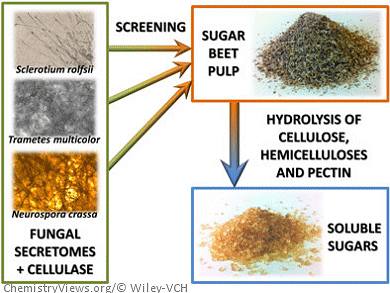Enzymatic hydrolysis of biomass is a widely employed strategy to obtain soluble sugars for the subsequent production of second generation biofuels. A potential raw material is sugar beet pulp (SBP), a by-product of the table sugar industry. The efficiency of enzymatic hydrolysis of SBP into sugars is low owing to its complex composite structure of cellulose, hemicellulose, and pectin, which hinders hydrolytic enzymes to access their respective substrates.
Roland Ludwig, University of Natural Resources and Life Sciences, Vienna, Austria, and colleagues investigated the efficiency of enzymatic hydrolysis of three different fungal strains on SBP. The hydrolytic power of these wood degrading fungi arises from the complex interplay of their secreted hydrolytic and redox enzymes, so called exoenzymes.
The team identified the plant pathogenic fungus Sclerotium rolfsii as a versatile producer of a mix of enzymes when grown on the cheap SBP medium. Major constituents of SBP, especially hemicellulose, are degraded efficiently. This results in the release of different soluble sugars, such as glucose, xylose, and arabinose, which subsequently can be used for the production of valuable biofuels.
- Fungal secretomes enhance sugar beet pulp hydrolysis,
Daniel Kracher, Damir Oros, Wanying Yao, Marita Preims, Iva Rezic, Dietmar Haltrich, Tonci Rezic, Roland Ludwig,
Biotechnol. J. 2014.
DOI: 10.1002/biot.201300214




